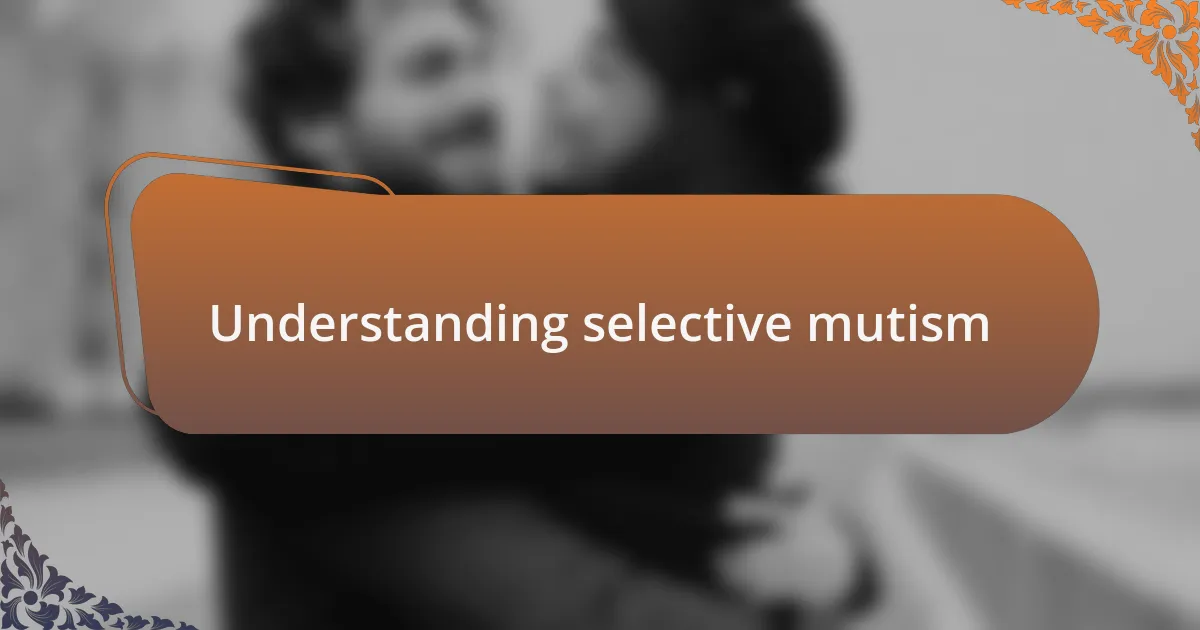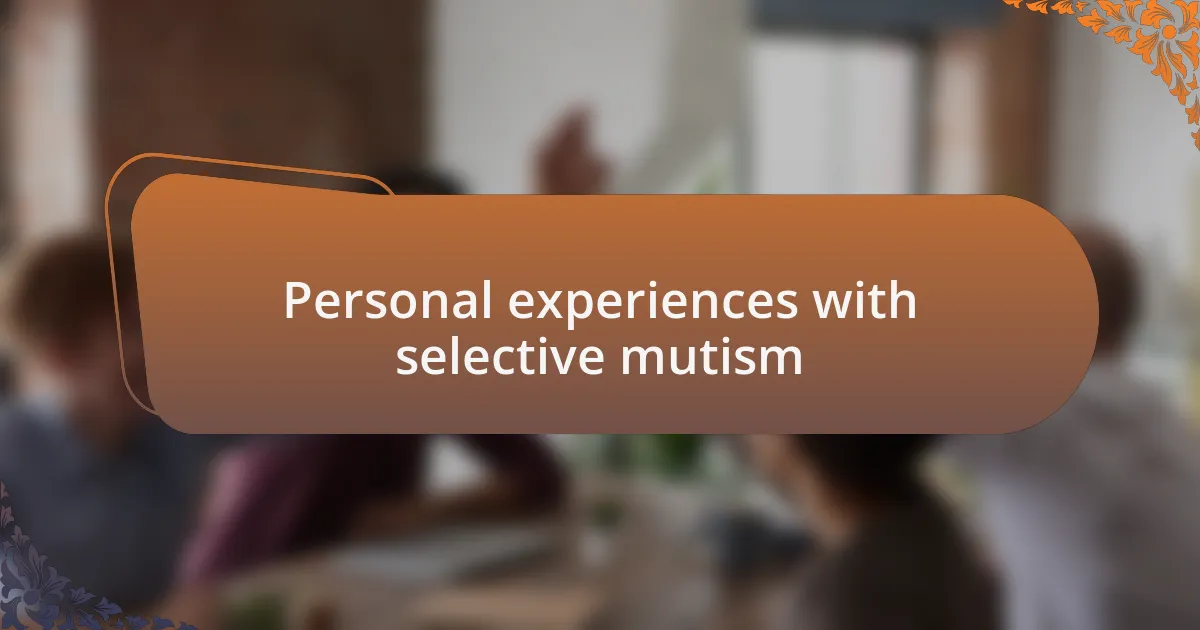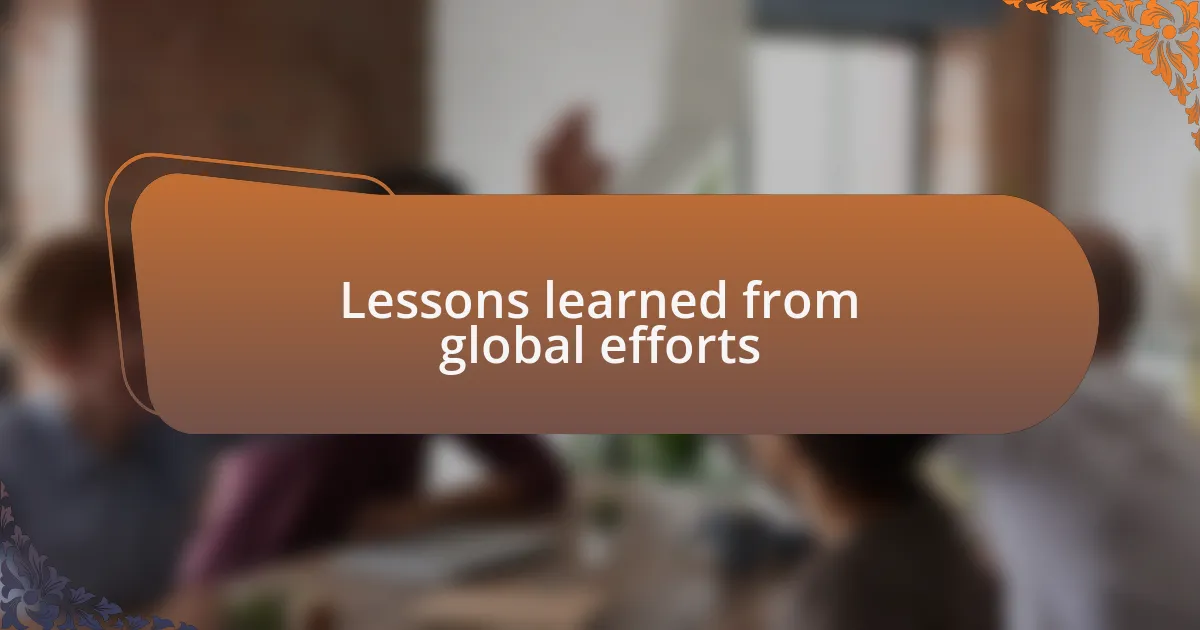Key takeaways:
- Selective mutism is driven by anxiety, not shyness, requiring empathetic approaches to support affected children.
- Global research reveals diverse cultural attitudes impact perceptions and treatments of selective mutism, highlighting the value of collaboration in therapeutic strategies.
- Personal narratives and community awareness initiatives can significantly improve understanding and support for individuals with selective mutism.
- Early intervention and building supportive networks are crucial for empowering children and reducing stigma associated with selective mutism.

Understanding selective mutism
Selective mutism is often misunderstood as shyness, but it’s so much more profound. I remember a friend sharing stories about her child who would speak freely at home yet became completely silent in school. This stark contrast highlights the anxiety that underlies selective mutism—it’s not a choice but a response to overwhelming fear in social situations.
When children face selective mutism, it creates a challenging environment not just for them but for their families too. I’ve seen firsthand how this silence can lead to frustration and feelings of helplessness. What if someone told you that developing communication skills isn’t just about speaking but also about creating a safe space for expression? It’s essential to nurture environments that make these children feel comfortable to share their voices.
Understanding selective mutism means recognizing that it’s a complex interplay of emotional and psychological factors. Think about the pressure children feel; how would you respond if you were in their shoes? I often reflect on the necessity for empathy and patience in such cases—these children need support to gradually find their voice in a world that can feel so intimidating.

Importance of global research
Global research plays a crucial role in deepening our understanding of selective mutism. I recall attending a conference where researchers from various countries shared their findings, revealing that cultural attitudes toward communication significantly influence how selective mutism is perceived and treated. Wouldn’t it be fascinating to see how diverse approaches could shape a child’s journey toward finding their voice?
Exploring data from international studies sheds light on common patterns in selective mutism, highlighting the importance of collaboration. I remember my own surprise when learning how specific therapeutic techniques successful in one culture could be adapted to help children in another. How can we select the most effective methods if we don’t consider the wealth of global knowledge available?
Additionally, research initiatives that span different countries enrich our toolkit for supporting children and families affected by selective mutism. I often think about how, by embracing these findings, we create more inclusive strategies tailored to various environments. Isn’t it empowering to know that even small insights from around the world can lead to a profound impact on a child’s ability to communicate?

Key findings from research initiatives
Research initiatives have uncovered several notable findings regarding the therapeutic methods used to support children with selective mutism. For instance, I recently came across a study from Australia that highlighted the effectiveness of group therapy combining play with communication strategies. It struck me how children thrived in these settings, gradually building confidence through shared experiences. Doesn’t it make you wonder how much more we could achieve with collaborative approaches?
Another intriguing discovery from a European research project emphasized the role of parental involvement in treatment. I’ve seen firsthand how engaged parents can significantly influence a child’s progress. One mother I met shared her journey of learning strategies to encourage her son at home, ultimately leading to remarkable breakthroughs. Isn’t it heartening to realize that our involvement can make such a difference?
Moreover, a comprehensive analysis of cross-cultural studies revealed that the weight of societal expectations profoundly affects children’s experiences with selective mutism. Reflecting on my conversations with families from different backgrounds, I recognize that the fear of judgment often exacerbates communication difficulties. What if we focused more on fostering acceptance and understanding in our communities? This approach could redefine how we support children on their path to effective communication.

Practical strategies for awareness
Raising awareness about selective mutism can start with sharing stories that resonate. I once attended a community meeting where a parent bravely shared their child’s struggles. It was incredible to see the room shift from confusion to understanding, proving that personal narratives have the power to foster empathy. Could we replicate this emotional connection through local workshops or support groups, tapping into the strength of shared experiences?
Another practical strategy is harnessing social media platforms to amplify awareness. I’ve witnessed campaigns that successfully reached thousands by simply sharing authentic testimonials and informative posts. Imagine if each of us committed to sharing a post or story; we could create a ripple effect, transforming the dialogue around selective mutism and encouraging others to engage. Isn’t it fascinating how a few clicks could lead to broader understanding and support?
Lastly, collaborating with schools can be immensely impactful. Engaging educators in the conversation, perhaps through training sessions, helps them recognize the signs of selective mutism and understand how to respond appropriately. I recall a school counselor who told me about a small training session led by a specialist. It changed the way the entire staff approached shy children, fostering an environment where every child feels safe to express themselves. What if we made this standard practice in all schools?

Personal experiences with selective mutism
When I think back to my early experiences with selective mutism, I can vividly recall feeling trapped in silence during classroom activities. I remember a particularly stressful day when the teacher called on me to share my thoughts on a book, and all I could muster was a small nod. It felt as if my voice was caught in a bubble, and I wondered if anyone truly understood my struggle. Have you ever felt that isolation, even in a crowded room?
I also had a profound conversation with another individual facing similar challenges. We exchanged stories about how our loved ones sometimes misinterpreted our silence as rudeness or disinterest. This shared understanding emphasized how crucial it is for those around us to realize that selective mutism is not about choice; it’s about an overwhelming fear that can paralyze our voices. Isn’t it eye-opening how empathy can transform the narrative of our experiences?
Reflecting on my journey, I’ve come to appreciate the small victories. For instance, there was a moment when I voluntarily participated in a group discussion, and I could feel my heart racing with both excitement and fear. After speaking, the supportive smiles from my peers filled me with a sense of accomplishment I hadn’t experienced in a long time. It made me realize that each step, no matter how small, plays a crucial role in overcoming the challenges of selective mutism. Have you ever celebrated a personal milestone that felt monumental in the grand scheme of your growth?

Lessons learned from global efforts
Lessons from global efforts have underscored the importance of early intervention in supporting children with selective mutism. In a recent collaboration with international researchers, I learned that approaches emphasizing individualized therapy not only reduce anxiety but also foster communication skills. Just think about how powerful it is to address these challenges early on, helping children feel understood and empowered.
I’ve also observed that community awareness plays a vital role in combating the stigma associated with selective mutism. Global initiatives have successfully brought together educators, parents, and mental health professionals in discussions about how silence can often mask a wealth of emotional experiences. Have you noticed how awareness can shift perspectives and promote a more supportive environment for individuals struggling with their voices?
Finally, the emphasis on building supportive networks has been a game changer. I recall participating in a global forum where various stakeholders shared their experiences and strategies. The conversations highlighted the effectiveness of peer support groups, which can offer both understanding and practical strategies. Isn’t it remarkable how connecting with others can create a sense of belonging and hope?